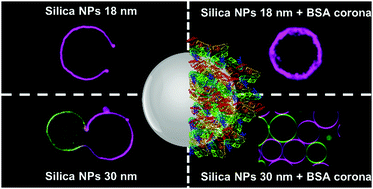Protein corona alters the mechanisms of interaction between silica nanoparticles and lipid vesicles†
Abstract
The use of nanoparticles (NPs) for biomedical applications implies their delivery into the organism where they encounter biological fluids. In such biological fluids, proteins and other biomolecules adhere to the surface of the NPs forming a biomolecular corona that can alter significantly the behaviour of the nanomaterials. Here, we investigate the impact of a bovine serum albumin corona on interactions between silica nanoparticles (SNPs) of two different sizes and giant lipid vesicles. The formation of the protein corona leads to a significant increase of the hydrodynamic size of the SNPs. Confocal microscopy imaging shows that the protein corona alters the morphological response of vesicles to SNPs. In addition, Laurdan spectral imaging show that the protein corona weakens the effect of SNPs on the lipid packing in the GUV membrane. Our results demonstrate that a protein corona can change the interaction mechanism between nanoparticles and lipid membranes.



 Please wait while we load your content...
Please wait while we load your content...